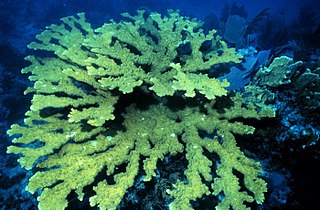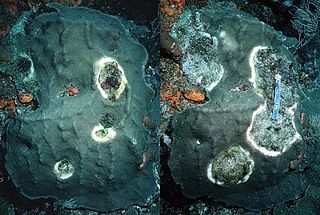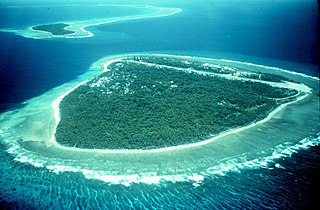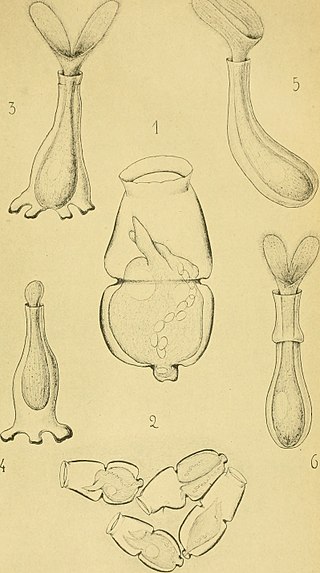Related Research Articles

A polyp in zoology is one of two forms found in the phylum Cnidaria, the other being the medusa. Polyps are roughly cylindrical in shape and elongated at the axis of the vase-shaped body. In solitary polyps, the aboral end is attached to the substrate by means of a disc-like holdfast called a pedal disc, while in colonies of polyps it is connected to other polyps, either directly or indirectly. The oral end contains the mouth, and is surrounded by a circlet of tentacles.

Serratia marcescens is a species of rod-shaped, Gram-negative bacteria in the family Yersiniaceae. It is a facultative anaerobe and an opportunistic pathogen in humans. It was discovered in 1819 by Bartolomeo Bizio in Padua, Italy. S. marcescens is commonly involved in hospital-acquired infections (HAIs), also called nosocomial infections, particularly catheter-associated bacteremia, urinary tract infections, and wound infections, and is responsible for 1.4% of HAI cases in the United States. It is commonly found in the respiratory and urinary tracts of hospitalized adults and in the gastrointestinal systems of children.

Pillar coral is a hard coral found in the western Atlantic Ocean and the Caribbean Sea. It is the only species in the monotypic genus Dendrogyra. It is a digitate coral -that is, it resembles fingers or a cluster of cigars, growing up from the sea floor without any secondary branching. It is large and can grow on both flat and sloping surfaces at depths down to 20 m (65 ft). It is one of the few types of hard coral in which the polyps can commonly be seen feeding during the day.

White band disease is a coral disease that affects acroporid corals and is distinguishable by the white band of exposed coral skeleton that it forms. The disease completely destroys the coral tissue of Caribbean acroporid corals, specifically elkhorn coral and staghorn coral. The disease exhibits a pronounced division between the remaining coral tissue and the exposed coral skeleton. These symptoms are similar to white plague, except that white band disease is only found on acroporid corals, and white plague has not been found on any acroporid corals. It is part of a class of similar disease known as "white syndromes", many of which may be linked to species of Vibrio bacteria. While the pathogen for this disease has not been identified, Vibrio carchariae may be one of its factors. The degradation of coral tissue usually begins at the base of the coral, working its way up to the branch tips, but it can begin in the middle of a branch.

Black band disease is a coral disease in which corals develop a black band. It is characterized by complete tissue degradation due to a pathogenic microbial consortium. The mat is present between apparently healthy coral tissue and freshly exposed coral skeleton.

The staghorn coral is a branching, stony coral, within the Order Scleractinia. It is characterized by thick, upright branches which can grow in excess of 2 meters in height and resemble the antlers of a stag, hence the name, Staghorn. It grows within various areas of a reef but is most commonly found within shallow fore and back reefs, as well as patch reefs, where water depths rarely exceed 20 meters. Staghorn corals can exhibit very fast growth, adding up to 5 cm in new skeleton for every 1 cm of existing skeleton each year, making them one of the fastest growing fringe coral species in the Western Atlantic. Due to this fast growth, Acropora cervicornis, serve as one of the most important reef building corals, functioning as marine nurseries for juvenile fish, buffer zones for erosion and storms, and center points of biodiversity in the Western Atlantic.

Elkhorn coral is an important reef-building coral in the Caribbean. The species has a complex structure with many branches which resemble that of elk antlers; hence, the common name. The branching structure creates habitat and shelter for many other reef species. Elkhorn coral is known to grow quickly with an average growth rate of 5 to 10 cm per year. They can reproduce both sexually and asexually, though asexual reproduction is much more common and occurs through a process called fragmentation.
Halofolliculina corallasia is a species of heterotrich ciliates identified as a cause of the syndrome called skeletal eroding band (SEB). It is the first coral disease pathogen that is a protozoan as well as the first known to be a eukaryote; all others identified are bacteria. Like other members of the folliculinid family, H. corallasia is sessile and lives in a "house" called a lorica, into which the cell can retreat when disturbed. The mouth is flanked by a pair of wing-like projections that are fringed with polykinetids, groups of cilia that work in groups to produce a current that draws food into the "mouth".

White pox disease, first noted in 1996 on coral reefs near the Florida Keys, is a coral disease affecting Elkhorn coral throughout the Caribbean. It causes irregular white patches or blotches on the coral that result from the loss of coral tissue. These patches distinguish white pox disease from white band disease which produces a distinctive white band where the coral skeleton has been denuded. The blotches caused by this disease are also clearly differentiated from coral bleaching and scars caused by coral-eating snails. It is very contagious, spreading to nearby coral.

Yellow-band disease is a coral disease that attacks colonies of coral at a time when coral is already under stress from pollution, overfishing, and climate change. It is characterized by large blotches or patches of bleached, yellowed tissue on Caribbean scleractinian corals.

Human activities have substantial impact on coral reefs, contributing to their worldwide decline. Damaging activities encompass coral mining, pollution, overfishing, blast fishing, as well as the excavation of canals and access points to islands and bays. Additional threats comprise disease, destructive fishing practices, and the warming of oceans.[2] Furthermore, the ocean's function as a carbon dioxide sink, alterations in the atmosphere, ultraviolet light, ocean acidification, viral infections, the repercussions of dust storms transporting agents to distant reefs, pollutants, and algal blooms represent some of the factors exerting influence on coral reefs. Importantly, the jeopardy faced by coral reefs extends far beyond coastal regions. The ramifications of climate change, notably global warming, induce an elevation in ocean temperatures that triggers coral bleaching—a potentially lethal phenomenon for coral ecosystems.

Colpophyllia is a genus of stony corals in the family Mussidae. It is monotypic with a single species, Colpophyllia natans, commonly known as boulder brain coral or large-grooved brain coral. It inhabits the slopes and tops of reefs, to a maximum depth of 50 metres (164 ft). It is characterised by large, domed colonies, which may be up to 2 metres across, and by the meandering network of ridges and valleys on its surface. The ridges are usually brown with a single groove, and the valleys may be tan, green, or white and are uniform in width, typically 2 centimetres (0.8 in). The polyps only extend their tentacles at night.

Acropora prolifera, the fused staghorn coral, is a branching, colonial, stony coral found in shallow parts of the Caribbean Sea, the Bahamas and southern Florida.

Dichocoenia is a monotypic genus of stony coral in the family Meandrinidae. It is represented by a single species, Dichocoenia stokesii, which is commonly known as pineapple coral, elliptical star coral, or pancake star coral. It is mostly found in the Caribbean Sea and the western Atlantic Ocean. Dichocoenia stokesii has irregular calyces and its form can be either a massive, hemispherical hump or a flat, platform-like structure.
Cymo melanodactylus, the furry coral crab, is a species of small decapod crustacean in the family Xanthidae. It is found in the Indo-Pacific Ocean and lives in crevices and on the surface of corals in the genus Acropora.

A corallivore is an animal that feeds on coral. Corallivores are an important group of reef organism because they can influence coral abundance, distribution, and community structure. Corallivores feed on coral using a variety of unique adaptations and strategies. Known corallivores include certain mollusks, annelids, fish, crustaceans, flatworms and echinoderms. The first recorded evidence of corallivory was presented by Charles Darwin in 1842 during his voyage on HMS Beagle in which he found coral in the stomach of two Scarus parrotfish.

The Folliculinidae are a family of ciliates in the class Heterotrichea, with the common name "bottle-animalcule".
Coral diseases are transmissible pathogens that cause the degradation of coral colonies. Coral cover in reef ecosystems has decreased significantly for a diverse set of reasons, ranging from variable environmental conditions to mechanical breakdowns from storms. In recent years, diseases that infect and kill coral have shown to be a threat to the health of coral reefs. Since the first coral disease was reported in 1965, many different kinds of diseases have popped up in mostly Caribbean waters. These diseases are diverse, including pathogens of bacteria, fungi, viruses, and protozoans. Coral diseases have widespread implications, impacting entire ecosystems and communities of organisms. Researchers are working to understand these diseases, and how potential treatments could stop these pathogens from causing the widespread death of corals in a way that permanently impacts the community structure of reefs.
Terpios hoshinota is a species of sea sponge belonging to the family Suberitidae. It is found on rocky shores in the Indo-Pacific region. This sponge forms blackish sheets which overgrow and kill corals, and is the causal agent for the so-called "black disease" of corals. Since being discovered in Guam in 1973, this sponge has been spreading to other areas of the Indo-Pacific region and threatening coral reefs from the Maldives to the South China Sea and eastern Australia.

Kimberly B. Ritchie is an American marine biologist. She is an Associate Professor in the Department of Natural Sciences at the University of South Carolina Beaufort. Her research is focused on marine microbiology and how microbes affect animal health in hosts such as corals and sharks.
References
- 1 2 3 4 5 Antonius, Arnfried A., Lipscomb, Diana (2001). "First Protozoan Coral-killer identified in the Indo-Pacific" (PDF). Atoll Research Bulletin (481). Smithsonian Institution: 1–21. Archived from the original (PDF) on 2009-09-19. Retrieved 2009-08-15.
{{cite journal}}: CS1 maint: multiple names: authors list (link) - 1 2 Richardson, L.L.; Yossi Loya (2004-06-14). "Black band disease". In Rosenberg, E.; Loya, Y. (eds.). Coral health and disease. Springer. pp. 325–336. ISBN 3-540-20772-4 . Retrieved 2009-08-16.
- 1 2 3 Rodríguez, S.; Cróquer, A.; Guzmán, H. M.; Bastidas, C. (March 2009). "A mechanism of transmission and factors affecting coral susceptibility to Halofolliculina sp. infection" (PDF). Coral Reefs. 28 (1): 67–77. Bibcode:2009CorRe..28...67R. doi:10.1007/s00338-008-0419-y. S2CID 25104122. Archived from the original (PDF) on 2011-09-10. Retrieved 2009-08-16.
- ↑ Page, C.; Willis, B. (June 2008). "Epidemiology of skeletal eroding band on the Great Barrier Reef and the role of injury in the initiation of this widespread coral disease". Coral Reefs. 27 (2): 257–272. Bibcode:2008CorRe..27..257P. doi:10.1007/s00338-007-0317-8. S2CID 34825367.
- ↑ Sutherland, Kathryn Patterson; Kim B. Ritchie. "White Pox Disease of the Caribbean Elkhorn Coral, Acropora palmata" (PDF). Archived from the original (PDF) on 2011-07-19. Retrieved 2009-08-22.
- ↑ Patterson KL, Porter JW, Ritchie KB, et al. (June 2002). "The etiology of white pox, a lethal disease of the Caribbean elkhorn coral, Acropora palmata". Proc Natl Acad Sci USA. 99 (13): 8725–30. doi: 10.1073/pnas.092260099 . PMC 124366 . PMID 12077296.
- ↑ Little, W.; Fowler, H.W; Coulson, J.; Onions, C.T. (1964). "Lorica". Shorter Oxford English Dictionary. Oxford University Press.
- ↑ Lynn, Denis H. (2008). "Subphylum 1, Postciliodesmatophora: Class2, Heterotrichea". The Ciliated Protozoa: Characterization, Classification, and Guide to the Literature (3rd ed.). Springer. pp. 129–139. ISBN 978-1-4020-8238-2 . Retrieved 2009-08-16.
- ↑ Cróquer, A.; Bastidas, C.; Lipscomp, D.; et al. (May 2006). "First report of folliculinid ciliates affecting Caribbean scleractinian corals". Coral Reefs. 25 (2): 187–191. Bibcode:2006CorRe..25..187C. doi:10.1007/s00338-005-0068-3. S2CID 9896965.
